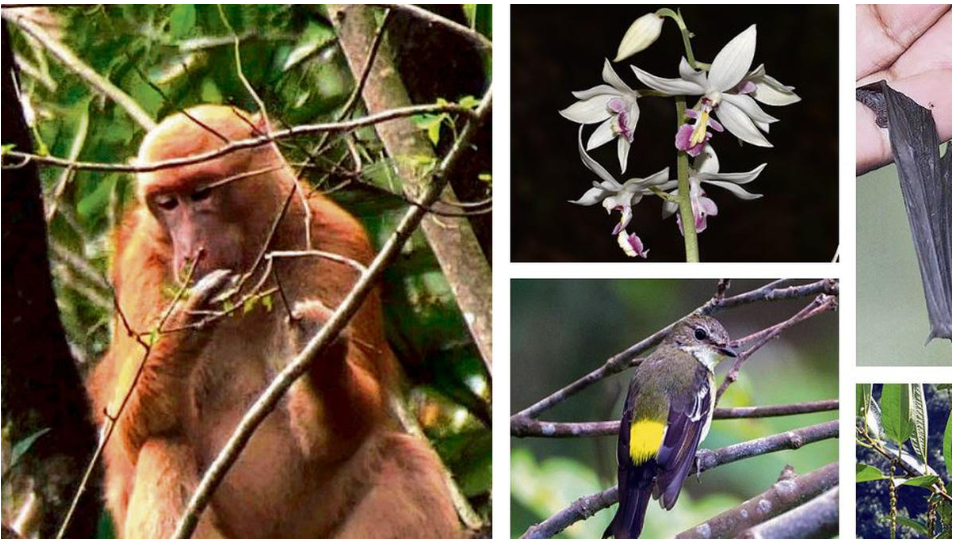India Updates Faunal and Floral Database

Disclaimer: Copyright infringement not intended.
Context
- India added more than 1000 species of flora and fauna in its database in 2022.
- It includes 664 animal species and 339 flora species.
- From Kerala state, maximum new animals and plants were discovered.
Other Information
- Flora Database - 339 new plant taxa
- 186 taxa that are new to science
- 153 taxa as new distributional records
- Faunal Databease - 664 animal species (Fauna diversity now increased to 1,03,922)
- 467 new species
- 197 new records
- New records refer to the species which are found in India for the first time.
- These discoveries have been compiled in -
- Faunal discoveries - in ‘Animal Discoveries - New Species and New Records 2023’, a publication by Zoological Survey of India (ZSI)
- Floral discoveries - in ‘Plant Discoveries 2022’ published by the Botanical Survey of India (BSI).
More information about major fauna species discovered
In Faunal species
- Maximum were invertebrates with 583 species.
- Vertebrates constituted 81 species.
- Fish dominated among vertebrates
- Insects - 384 species
Mammals
- Three new species and one new record;
- 2 species of Bats –
- Miniopterus phillipsi - a long-fingered bat, and
- Glischropus meghalayanus, a bamboo-dwelling bat – both from Meghalaya.
- Sela macaque (Macaca selai), - a new macaque species, Sela Pass, from parts of western and central Arunachal Pradesh.
- Macaca leucogenys – a new record of white-cheeked from West Siang, Arunachal Pradesh. It was earlier found in Modog, southeastern Tibet.
- Ficedula zanthopygia - the yellow-rumped flycatcher from Narcondam Island of the Andaman archipelago. It was earlier found in Mongolia, Transbaikal, southern China, Korea, western Japan.
Birds
- Two new records;
Reptiles
- 30 New species and two new records;
Amphibian
- Six new species and one new record;
Fish
- 28 new species and eight new records.
Region wise details
- Maximum new discoveries, 14.6%, were recorded from Kerala with 82 animal species new to science and 15 new records.
- From Karnataka 64 new species and 24 new records are found. These are 13.25% of total.
- In Tamil Nadu 71 there were new discoveries and 13 new records which is 12.6% of the total of new species discovered.
- Contribution of Andaman and Nicobar Islands - 4%
- Contribution of West Bengal - 7.6 %
- Contribution of Arunachal Pradesh - 5.7% from.
In Plant Discoveries
- 339 taxa (319 species, and 20 infraspecific taxa) including wild relatives of of horticultural, agricultural, medicinal, and ornamental plants
- 186 taxa - new to science and
- 153 taxa - new distributional records.
- The plant discovery includes include 125 angiosperms, 1 gymnosperm, 5 pteridophytes, 19 bryophytes, 55 lichens, 99 fungi, 27 algae and 9 microbes..
- Calanthe lamellose – a new record of an orchid species from the Japfu mountain range in Kohima, Nagaland. It was found in China and Myanmar earlier.
Contribution to the new discoveries
- Seed plants contributed maximum towards new discoveries – which is 37% of total.
- Dicotyledons - 73% and
- Monocotyledons - 27%
- Fungi - 29%
- Lichen - 16%
- Algae - 8%
- Bryophytes - 6%
- Microbes - 3% and
- Pteridophytes – 1%
Region and State wise Details
- Western Himalayas - 21% of the total discoveries
- It was followed by Western Ghats which stands at 16%
- Maximum from Kerala – 57 discoveries (16.8% of all plant discoveries of 2022)
- Nandadevia Pusalkar, - new genus of plants was discovered
- This genus is endemic to the southern Western Ghats of India and common throughout the foothills and warm outer valleys of the Uttarakhand Himalayas, and Nilgiriella Pusalkar.
- It is distributed in Karnataka, Kerala and Tamil Nadu.
Zoological survey of India
- This was established on 1 July, 1916 which is headquartered at Kolkata.
- It is an organization of Ministry of Environment, Forests and climate change.
- Its primary objectives are –
- Exploration, Survey, Inventorying and Monitoring of faunal diversity in various States, Ecosystems and Protected areas of India.
- Taxonomic studies of all faunal components collected.
- Periodic review of the Status of Threatened and Endemic species.
- Preparation of Red Data Book, Fauna of India and Fauna of States.
- Bioecological studies on selected important communities/species.
- Preparation of databases for the recorded species of the country.
- Maintenance & Development of National Zoological Collections.
- Training, Capacity Building and Human Resource Development.
- Faunal Identification, Advisory services and Library Services.
- Publication of results including Fauna of India and Fauna of States.
Botanical Survey of India
- This is also an organization which is subordinate to Ministry of Environment, Forests and climate change.
- This organization was established in the year 1890.
- Its main objectives are –
- Undertaking intensive floristic surveys and collecting accurate and detailed information on the occurrence, distribution, ecology and economic utility of plants in the country;
- Collecting, identifying and distributing materials that may be of use to educational and research institutions; and
- Acting as the custodian of authentic collections in well planned herbaria and documenting plant resources in the form of local, district, state and national flora.
|
PRACTICE QUESTION Consider the following statements about new discoveries of flora and species in 2022: 1. Less new fauna species were discovered in comparison to flora species. 2. The organization responsible to discover fauna species is Zoological survey of India. Which of the statements given above is/are correct? A. 1 only B. 2 only C. Both 1 and 2 D. Neither 1 nor 2 Answer: (D) |





1.png)
